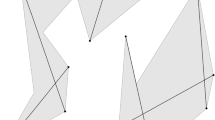Abstract
The skeleton is an effective tool for shape analysis if its structure can be regarded as a faithful stick-like representation of the pattern. However, contour noise may affect this structure by originating spurious skeleton branches, so that skeletonization algorithms should include a pruning phase devoted to an analysis of the peripheral skeleton branches and, possibly, to their partial or total removal. In this paper, labeled skeletons are considered and the significance of a peripheral branch is evaluated by analyzing the type of interaction between the pattern subset corresponding to the peripheral branch and the pattern subsets corresponding to the skeleton branches adjacent to the peripheral branch. The proposed criteria for skeleton pruning are expressed in terms of four parameters, which as a whole describe the role that the pattern subset corresponding to the peripheral branch plays in the characterization of the shape of the pattern.
Access this chapter
Tax calculation will be finalised at checkout
Purchases are for personal use only
Preview
Unable to display preview. Download preview PDF.
Similar content being viewed by others
References
G. Sanniti di Baja and E. Thiel: (3,4)-weighted skeleton decomposition for pattern representation and description. Pattern Recognition, 27 (1994) 1039–1049.
D. Shaked and A. M. Bruckstein: Pruning medial axes. Computer Vision and Image Understanding, 69 (1998) 156–169.
G. Borgerfors: Distance transformations in digital images. CVGIP, 34 (1986) 344–371.
M. Frucci and A. Marcelli: Efficient skeletonization of binary figures through (d1,d2)-erosion and directional information. In: C. Arcelli, L.P. Cordella and G. Sanniti di Baja (eds.): Aspects of Visual Form Processing, World Scientific, Singapore (1994) 221–230.
H. Blum: Biological shape and visual science (part I). Journal of Theoretical Biology, 38 (1973) 205–287.
C. Arcelli and G. Sanniti di Baja: Skeletons of planar patterns. In: T.Y. Kong and. A. Rosenfeld (eds.):Topological Algorithms for Digital Image Processing, North Holland, Amsterdam (1996) 99–143.
Author information
Authors and Affiliations
Editor information
Editors and Affiliations
Rights and permissions
Copyright information
© 2001 Springer-Verlag Berlin Heidelberg
About this paper
Cite this paper
De Stefano, C., Frucci, M. (2001). Spatial Relations among Pattern Subsets as a Guide for Skeleton Pruning. In: Arcelli, C., Cordella, L.P., di Baja, G.S. (eds) Visual Form 2001. IWVF 2001. Lecture Notes in Computer Science, vol 2059. Springer, Berlin, Heidelberg. https://doi.org/10.1007/3-540-45129-3_13
Download citation
DOI: https://doi.org/10.1007/3-540-45129-3_13
Published:
Publisher Name: Springer, Berlin, Heidelberg
Print ISBN: 978-3-540-42120-7
Online ISBN: 978-3-540-45129-7
eBook Packages: Springer Book Archive




